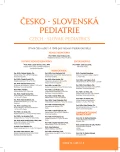Fatal meningococcal sepsis caused by Neisseria meningitidis serogroup W
Authors:
L. Krbková 1; M. Fedora 2; J. Pavelka 1; P. Křížová 3; K. Labská 4; Z. Vacková 3
Authors‘ workplace:
Klinika dětských infekčních nemocí, LF MU a FN Brno
1; Klinika dětské anesteziologie a resuscitace, LF MU a FN Brno
2; Národní referenční laboratoř pro meningokokové nákazy, Státní zdravotní ústav, Praha
3; Národní referenční laboratoř pro herpetické viry, Státní zdravotní ústav, Praha
4
Published in:
Čes-slov Pediat 2017; 72 (5): 322-324.
Category:
Case Report
Overview
We present a fatal course of meningococcal infection. The patient was a seventeen-year-old girl with one-day history of abdominal pain and diarrhoe. At the time of admission, she was unconscious (Glasgow Coma Scale 3), ecchymoses were present on the skin, hypotension with non-palpable peripheral pulsation developed and capillary return was prolonged. Leukopenia, thrombocytopenia, anemia, coagulopathy and severe lactic acidosis dominated in laboratory findings. The girl died of hypodynamic septic shock refractory to the treatment 4 hours after admisson. Neisseria meningitidis was confirmed by a noncultivation method from the spleen tissue and the presence of capsular gene synG by rt-PCR determined the strain belonging to the serogroup W.
KEY WORDS:
meningococcal sepsis, serogroup W, multiorgan failure, quadrivalent meningococcal conjugate vaccine A, C, Y, W
Sources
1. Křížová P, Musílek M, Vacková Z, et al. Invazivní meningokokové onemocnění v České republice v roce 2015. Zprávy CEM (SZÚ Praha) 2016; 25 (3): 94–100.
2. MacNeil JR, Medah I, Koussoubé D, et al. Neisseria meningitidis serogroup W, Burkina Faso, 2012. Emerg Infect Dis 2014; 20 (3): 394–399.
3. Ladhani SN, Beebeejaun K, Lucidarme J, et al. Increase in endemic Neisseria meningitidis capsular group W sequence type 11 complex associated with severe invasive disease in England and Wales. Clin Infect Dis 2015; 60 (4): 578–585.
4. Lucidarme J, Scott KJ, Ure R, et al. An international invasive meningococcal disease outbreak due to a novel and rapidly expanding serogroup W strain, Scotland and Sweden, July to August 2015. Euro Surveill 2016; 21 (45): doi: http://dx.doi.org/10.2807/1560-7917.ES.2016.21.45.30395.
5. Křížová P. Zvýšený výskyt invazivního meningokokového onemocnění v Evropě způsobeného séroskupinou W. Zprávy CEM (SZÚ, Praha) 2015; 24 (6–7): 228–229.
6. Mustapha MM, March JW, Krauland MG, et al. Genomic epidemiology of hypervirulent serogroup W, ST-11 Neisseria meningitidis. J EBio Med 2015; 2: 1447–1455.
7. Taha MK, Achtman M, Alonso JM, et al. Serogroup W135 meningococcal disease in Hajj pilgrims. Lancet 2000; 356 (9248): 2159.
8. Smith-Palmer A, Oats K, Webster D, et al. Outbreak of Neisseria meningitidis capsular group W among Scouts returning from the World Scout Jamboree, Japan, 2015. Euro Surveill 2016; 21 (45): 22636.
9. Křížová P, Musílek M, Vacková Z, et al. Invazivní meningokokové onemocnění v České republice v roce 2011. Zprávy CEM (SZÚ, Praha) 2012; 21 (3): 106–111.
10. Janouškovcová H, Raděj J, Musílek M, et al. Infection by Neisseria meningitidis serogroup W135 belonging to the unusual clone ST-3342 in the Czech Republic. Folia Microbiol 2013; 58 (1): 85–86.
11. Van de Beek D, Cabellos C, Džupová O, et al. ESCMID Guideline: Diagnosis and treatment of acute bacterial meningitis. Clin Microbiol Infect 2016; 22: S37–62.
12. Džupová O, Helcl M, Kračmarová R, et al. Doporučený postup diagnostiky a léčby purulentních meningitid. Klin Mikrobiol Inf Lek 2017; v tisku.
13. Doporučení České vakcinologické společnosti pro očkování proti invazivním meningokokovým onemocněním. 25. února 2014: http://www.vakcinace.eu/data/files/downloads/dp_meningovakcinaci_2014final.pdf.
Labels
Neonatology Paediatrics General practitioner for children and adolescents Intensive Care Medicine Trauma surgeryArticle was published in
Czech-Slovak Pediatrics

2017 Issue 5
Most read in this issue
- Histamine intolerance in childhood – case reports from clinical praxis
- Enteral nutrition in the treatment of inflammatory bowel disease
- Correction of congenital breast and chest wall malformations by lipomodelling technique
- Perianal lesions – condylomata or Crohn’s disease?
